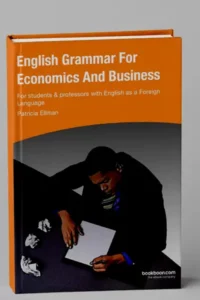The English Grammar for Economics and Business book is a must for all those students and professors of Economics and Business Studies with English as a Foreign Language (EFL) who need to write academic texts in English (essays, papers, Masters and Doctoral theses, articles, books).
It contains pertinent examples of the various aspects of grammar and style which are most relevant to these particular users.
English Grammar for Economics and Business PDF
The following points of English grammar, style and presentation are those which are most relevant for economics and business students with fairly advanced English as a Foreign Language (EFL). This guide represents a distillation on a need-to-know basis of the myriad points of grammar found in standard textbooks. Some students with EFL have access to in-house English courses, but many do not, and those who do often say they are too general to be useful.
The selected solecisms mainly concern the most common types of error that I have encountered over the course of 30 years, when working on around 2000 texts (articles, theses and books, both single- and multi-author) produced by EFL M.Phil. and Ph.D. students and academics. My client base includes authors from many different countries (e.g. the Netherlands, Italy, Portugal – including the Canary Islands, France, the Central and Eastern European countries, Morocco, Turkey, Ethiopia, Pakistan, Indonesia, and China. They write on a wide range of subjects, such as taxation policy, corporate social responsibility, educational economics, environmental economics (including insurance and measures taken against flood risk; road pricing; containerization; and airport logistics), urbanization processes, and network theory applied to commuting.
Amongst other things, the guide tackles such constantly recurring grammatical problems as:
- How to correctly place those slippery words: already, also, often and only in a sentence;
- When to use, or not use, the definite and indefinite articles (the, a/an);
- How to decide whether to use like or such as;
- When to use less and fewer, few and little, big, large and great; and
- How to choose between compared to and compared with.
In many cases, there is a clear right or wrong usage, but sometimes it is a case of knowing what is formal style, suitable for scholarly texts, and what is informal and therefore inappropriate in such texts. On a few occasions, it is simply a question of making a choice between two equally acceptable forms, and then sticking to that choice consistently.
Book Features
- content
- Acknowledgments
- introductory Remarks and Reference works Consulted
- 1. Explanation of common Errors in Alphabetical Order
- 2. Confusion Between Certain Words
- 3. Note On Style
- 4. The Finishing Touches: 22 Basic Tips For The Final Editing of texts and theses – a Checklist
Content
- Explanations of Common Errors in Alphabetical Order
- Confusion Between Certain Words
- Notes on Style
- The Finishing Touches: 22 Basic Tips for the Final Editing of Texts and Theses — a Checklist
- Everything You Always Wanted to Know about the Definite and the Indefinite Article (but Were too Confused to Know Where to Begin)
- Section 1: Analysis of presence or absence of the definite articles in various foreign languages Section 2: The first Diagnostic Test
- Section 3: The most widely-used constructions using the definite and indefinite articles
- Section 4: Final remarks on the use of the and a/an (not always as articles)
- Section 5: Reference essay: A key to the application of the 80 Rules for using/not using the articles
- Section 6: Concluding remarks to Chapter 5
- About the Author
- Endnotes


